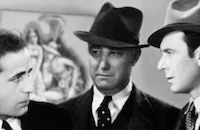The Chinese Ring
Brief Synopsis
Cast & Crew
William Beaudine
Roland Winters
Warren Douglas
Mantan Moreland
Louise Currie
Victor Sen Young
Film Details
Technical Specs

Synopsis
A Chinese princess arrives in San Francisco by boat and visits Detective Charlie Chan at his home. Before an assailant kills the princess by shooting a poison dart through a window, she gives Chan's butler, Birmingham, an ancient Chinese ring. As she dies, the princess writes "Captain K" on a piece of paper, but is unable to finish the captain's name. Chan calls police sergeant Bill Davidson to help him investigate the murder. Bill's friend, reporter Peggy Cartwright, arrives uninvited and identifies the princess as Mei Ling, who came from Asia a few weeks before on a ship captained by two men, Kong and Kelso. Chan soon learns that the princess came to the United States to purchase warplanes for her brother's army in the Orient and brought one million dollars with her. Kelso has received only half his payment, however, and Kong is anxious to receive his share of the arms sales. Peggy searches the princess' apartment, but hides when a masked man enters and ransacks the dresser. Peggy then meets Mei Ling's maid, Lilly Mae, and a boy who lives in the apartment basement. Later, Chan arrives and finds the maid dead. The boy, who is a deaf-mute, tells Chan with gestures that he saw a man enter Mei Ling's apartment. Chan then visits Armstrong, the banker who handled Mei Ling's traveler's checks, and Armstrong tells him that he had to put down one of his vicious guard dogs. Kong and Kelso, anxious to get the rest of their money before their boat sails at midnight, kidnap Chan and Armstrong, bind and gag them, and drive them onto the ship. Birmingham follows and calls Chan's son Tommy, and together they free Armstrong and Chan. Meanwhile, Peggy and Bill arrive, and when Kelso sees Peggy, he abducts her. Bill and the police come to her rescue, and Kong and Kelso are arrested. Chan then explains that it was Armstrong, not Kong and Kelso, who committed the murders. Armstrong stole Mei Ling's money, then swindled Kelso and Kong out of receiving the balance of their payment. He then killed the maid, as well as the boy, whom he buried instead of his dog. Pointing out that Peggy had phoned in her "scoop" implicating Kong and Kelso before he had exposed Armstrong, Chan insists that women are not meant for heavy thinking.

Director
William Beaudine
Cast

Roland Winters

Warren Douglas

Mantan Moreland

Louise Currie
Victor Sen Young
Philip Ahn

Byron Foulger
Thayer Roberts
Jean Wong
Cha Bing
George L. Spaulding
Paul Bryar
Thornton Edwards
Lee Tung Foo
Richard Wang
Spencer Chan
Kenneth Chuck

Jack Mower
Charmienne Harker
Crew

Film Details
Technical Specs

Quotes
Trivia
Notes
The title card on the film reads: "Charlie Chan in The Chinese Ring." The film's working titles were The Red Hornet and Charlie Chan and the Chinese Ring. Independent Film Journal reviewed the picture as The Red Hornet. This film marked the first "Charlie Chan" film to star Roland Winters. Winters was the third actor to portray "Chan" in the series, replacing Sidney Toler after his death earlier in 1947. Toler had replaced Warner Oland in the series, which began with the 1931 Fox film Charlie Chan Carries On. Although the CBCS lists Valerie Ardis as "Stenographer," the Variety review and studio production files list Charmienne Harker in the role. The Chinese Ring was a remake of the 1939 Monogram film Mr. Wong in Chinatown (see AFI Catalog of Feature Films, 1931-40; F3.2931. Scott Darling, who is credited with the original story for The Chinese Ring wrote the screenplay for the 1939 film. For more information on the series, consult the Series Index and see the entry for Charlie Chan Carries On in AFI Catalog of Feature Films, 1931-40; F3.0663.












